Organizational Structure of Sony Corporation: A Detailed Analysis
VerifiedAdded on 2022/08/24
|8
|2262
|19
Report
AI Summary
This report provides a comprehensive analysis of the organizational structure of Sony Corporation, focusing on its matrix design. It begins with an executive summary and an introduction, followed by a detailed examination of Sony's background, including its establishment, evolution, and diverse business segments such as electronics, entertainment, and financial services. The core of the report explores Sony's matrix organizational structure, highlighting the functional, business type, and geographical divisions within the company. The functional divisions include departments like CEO, Finance, R&D, and Sales, each with specific roles and reporting structures. Sony is also divided by business type (electronics, games, entertainment) and geographical regions. The report then evaluates the effectiveness of the matrix structure, emphasizing its flexibility and ability to link departmental activities. The conclusion summarizes the key findings, reinforcing the effectiveness of the matrix structure for Sony's operations. The report references several academic sources to support its analysis.
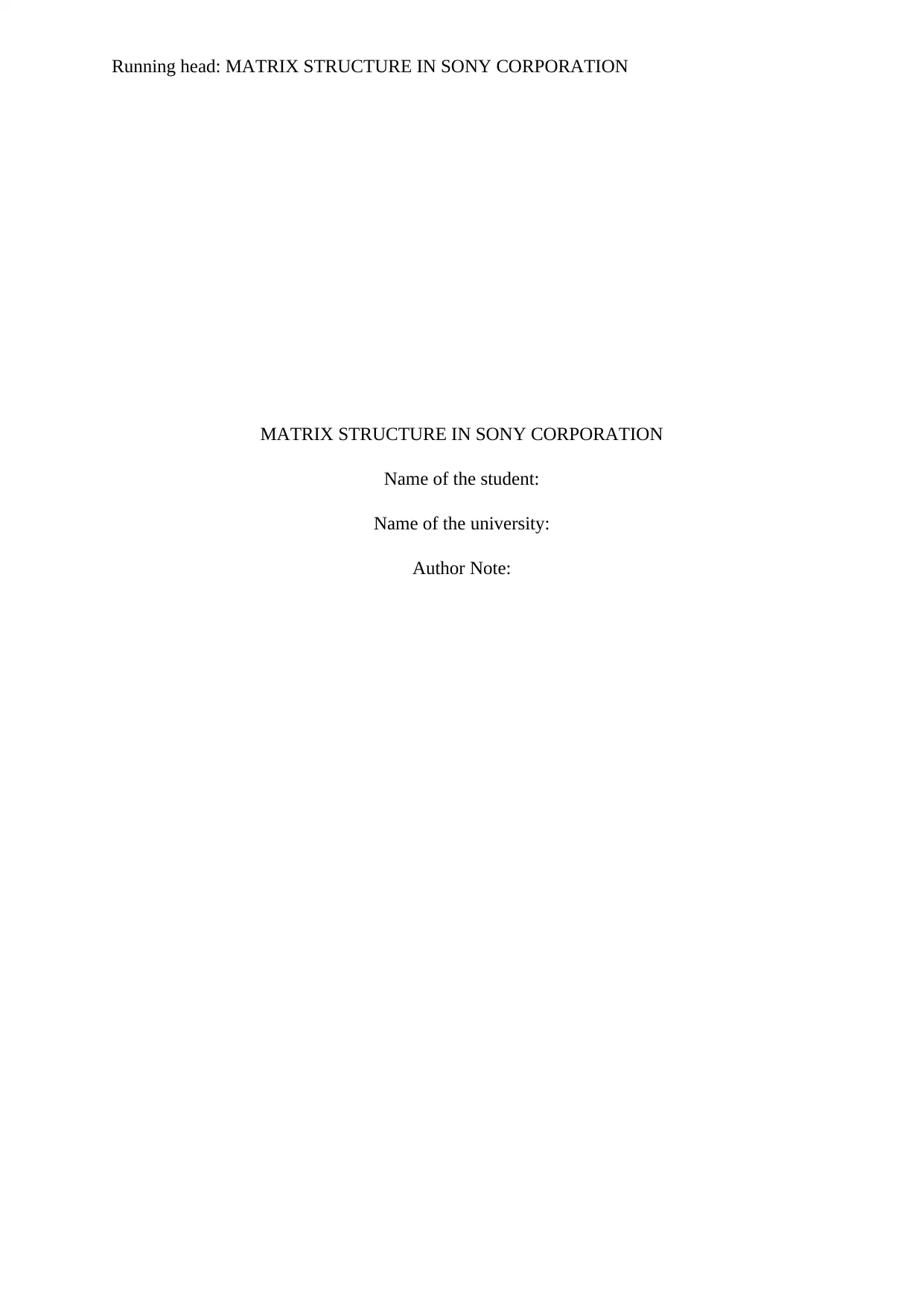
Running head: MATRIX STRUCTURE IN SONY CORPORATION
MATRIX STRUCTURE IN SONY CORPORATION
Name of the student:
Name of the university:
Author Note:
MATRIX STRUCTURE IN SONY CORPORATION
Name of the student:
Name of the university:
Author Note:
Paraphrase This Document
Need a fresh take? Get an instant paraphrase of this document with our AI Paraphraser
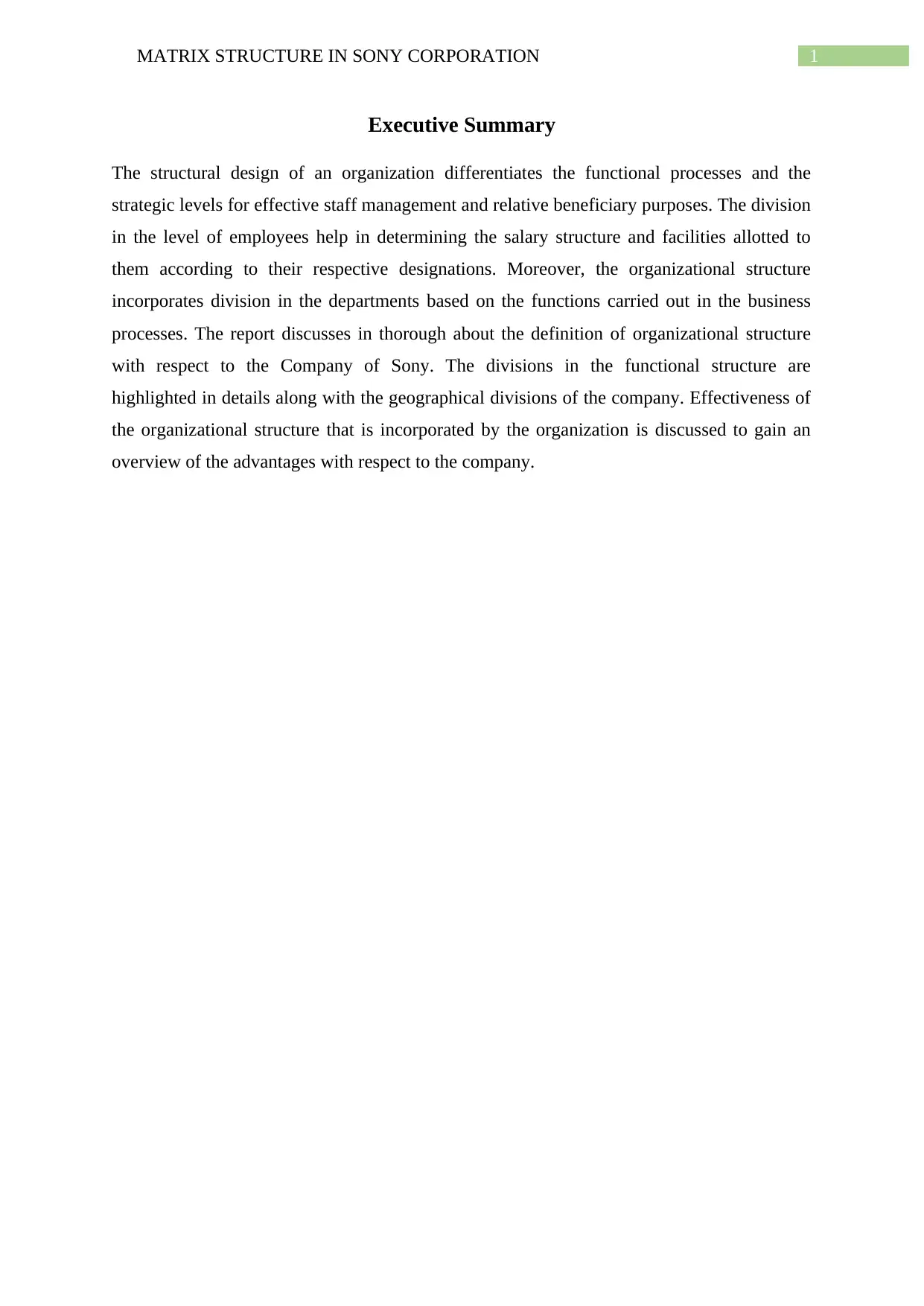
1MATRIX STRUCTURE IN SONY CORPORATION
Executive Summary
The structural design of an organization differentiates the functional processes and the
strategic levels for effective staff management and relative beneficiary purposes. The division
in the level of employees help in determining the salary structure and facilities allotted to
them according to their respective designations. Moreover, the organizational structure
incorporates division in the departments based on the functions carried out in the business
processes. The report discusses in thorough about the definition of organizational structure
with respect to the Company of Sony. The divisions in the functional structure are
highlighted in details along with the geographical divisions of the company. Effectiveness of
the organizational structure that is incorporated by the organization is discussed to gain an
overview of the advantages with respect to the company.
Executive Summary
The structural design of an organization differentiates the functional processes and the
strategic levels for effective staff management and relative beneficiary purposes. The division
in the level of employees help in determining the salary structure and facilities allotted to
them according to their respective designations. Moreover, the organizational structure
incorporates division in the departments based on the functions carried out in the business
processes. The report discusses in thorough about the definition of organizational structure
with respect to the Company of Sony. The divisions in the functional structure are
highlighted in details along with the geographical divisions of the company. Effectiveness of
the organizational structure that is incorporated by the organization is discussed to gain an
overview of the advantages with respect to the company.
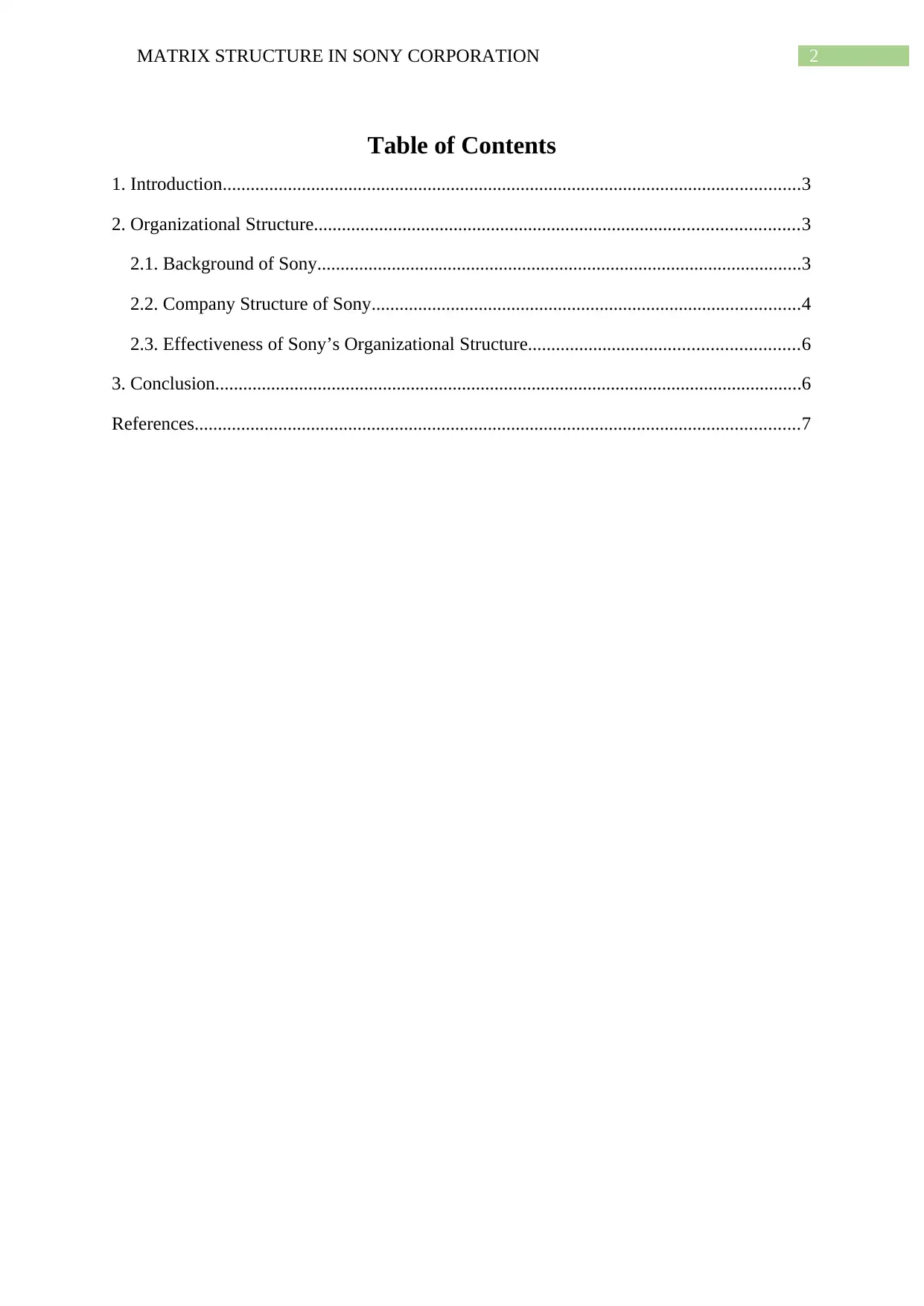
2MATRIX STRUCTURE IN SONY CORPORATION
Table of Contents
1. Introduction............................................................................................................................3
2. Organizational Structure........................................................................................................3
2.1. Background of Sony........................................................................................................3
2.2. Company Structure of Sony............................................................................................4
2.3. Effectiveness of Sony’s Organizational Structure..........................................................6
3. Conclusion..............................................................................................................................6
References..................................................................................................................................7
Table of Contents
1. Introduction............................................................................................................................3
2. Organizational Structure........................................................................................................3
2.1. Background of Sony........................................................................................................3
2.2. Company Structure of Sony............................................................................................4
2.3. Effectiveness of Sony’s Organizational Structure..........................................................6
3. Conclusion..............................................................................................................................6
References..................................................................................................................................7
⊘ This is a preview!⊘
Do you want full access?
Subscribe today to unlock all pages.

Trusted by 1+ million students worldwide
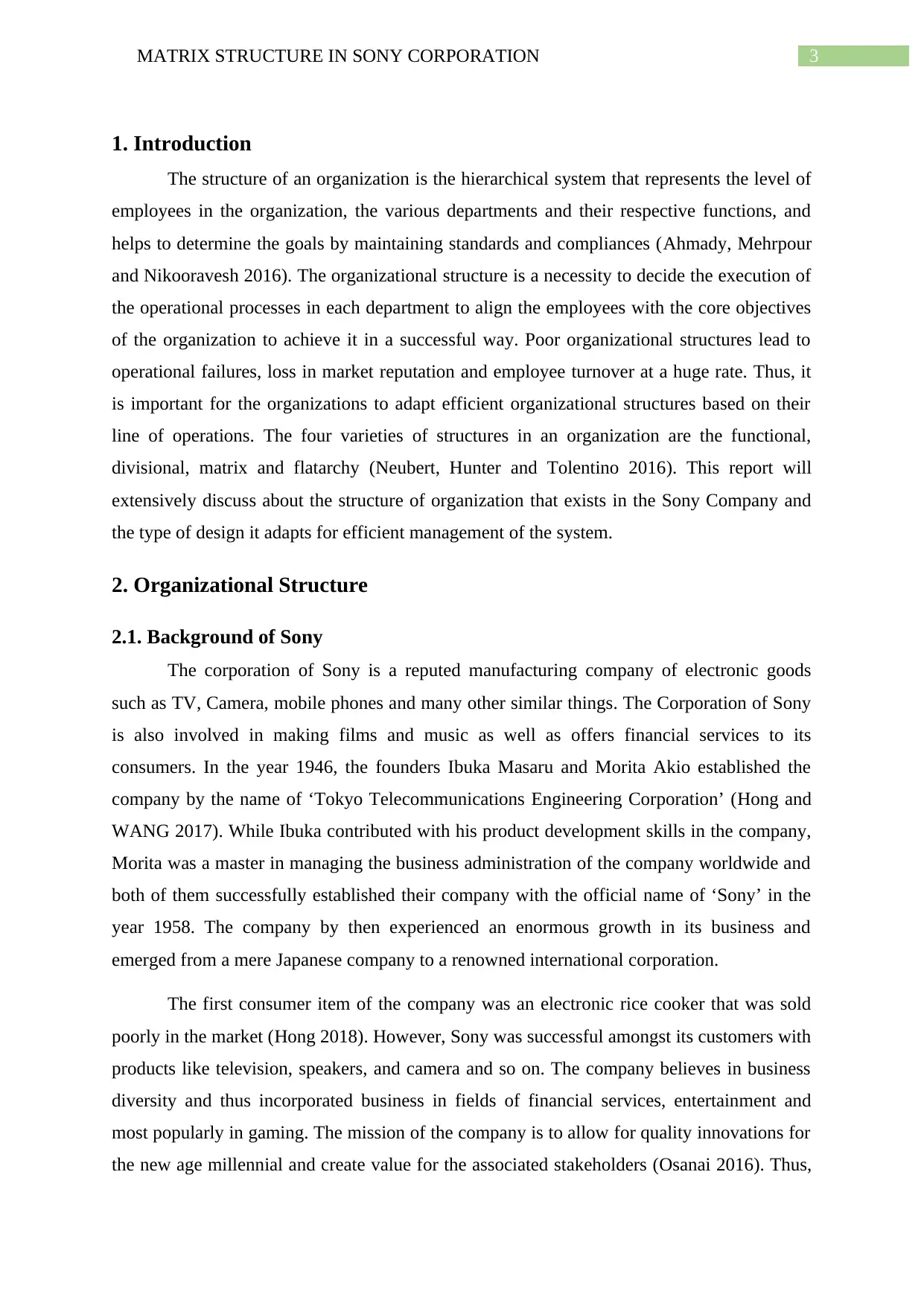
3MATRIX STRUCTURE IN SONY CORPORATION
1. Introduction
The structure of an organization is the hierarchical system that represents the level of
employees in the organization, the various departments and their respective functions, and
helps to determine the goals by maintaining standards and compliances (Ahmady, Mehrpour
and Nikooravesh 2016). The organizational structure is a necessity to decide the execution of
the operational processes in each department to align the employees with the core objectives
of the organization to achieve it in a successful way. Poor organizational structures lead to
operational failures, loss in market reputation and employee turnover at a huge rate. Thus, it
is important for the organizations to adapt efficient organizational structures based on their
line of operations. The four varieties of structures in an organization are the functional,
divisional, matrix and flatarchy (Neubert, Hunter and Tolentino 2016). This report will
extensively discuss about the structure of organization that exists in the Sony Company and
the type of design it adapts for efficient management of the system.
2. Organizational Structure
2.1. Background of Sony
The corporation of Sony is a reputed manufacturing company of electronic goods
such as TV, Camera, mobile phones and many other similar things. The Corporation of Sony
is also involved in making films and music as well as offers financial services to its
consumers. In the year 1946, the founders Ibuka Masaru and Morita Akio established the
company by the name of ‘Tokyo Telecommunications Engineering Corporation’ (Hong and
WANG 2017). While Ibuka contributed with his product development skills in the company,
Morita was a master in managing the business administration of the company worldwide and
both of them successfully established their company with the official name of ‘Sony’ in the
year 1958. The company by then experienced an enormous growth in its business and
emerged from a mere Japanese company to a renowned international corporation.
The first consumer item of the company was an electronic rice cooker that was sold
poorly in the market (Hong 2018). However, Sony was successful amongst its customers with
products like television, speakers, and camera and so on. The company believes in business
diversity and thus incorporated business in fields of financial services, entertainment and
most popularly in gaming. The mission of the company is to allow for quality innovations for
the new age millennial and create value for the associated stakeholders (Osanai 2016). Thus,
1. Introduction
The structure of an organization is the hierarchical system that represents the level of
employees in the organization, the various departments and their respective functions, and
helps to determine the goals by maintaining standards and compliances (Ahmady, Mehrpour
and Nikooravesh 2016). The organizational structure is a necessity to decide the execution of
the operational processes in each department to align the employees with the core objectives
of the organization to achieve it in a successful way. Poor organizational structures lead to
operational failures, loss in market reputation and employee turnover at a huge rate. Thus, it
is important for the organizations to adapt efficient organizational structures based on their
line of operations. The four varieties of structures in an organization are the functional,
divisional, matrix and flatarchy (Neubert, Hunter and Tolentino 2016). This report will
extensively discuss about the structure of organization that exists in the Sony Company and
the type of design it adapts for efficient management of the system.
2. Organizational Structure
2.1. Background of Sony
The corporation of Sony is a reputed manufacturing company of electronic goods
such as TV, Camera, mobile phones and many other similar things. The Corporation of Sony
is also involved in making films and music as well as offers financial services to its
consumers. In the year 1946, the founders Ibuka Masaru and Morita Akio established the
company by the name of ‘Tokyo Telecommunications Engineering Corporation’ (Hong and
WANG 2017). While Ibuka contributed with his product development skills in the company,
Morita was a master in managing the business administration of the company worldwide and
both of them successfully established their company with the official name of ‘Sony’ in the
year 1958. The company by then experienced an enormous growth in its business and
emerged from a mere Japanese company to a renowned international corporation.
The first consumer item of the company was an electronic rice cooker that was sold
poorly in the market (Hong 2018). However, Sony was successful amongst its customers with
products like television, speakers, and camera and so on. The company believes in business
diversity and thus incorporated business in fields of financial services, entertainment and
most popularly in gaming. The mission of the company is to allow for quality innovations for
the new age millennial and create value for the associated stakeholders (Osanai 2016). Thus,
Paraphrase This Document
Need a fresh take? Get an instant paraphrase of this document with our AI Paraphraser
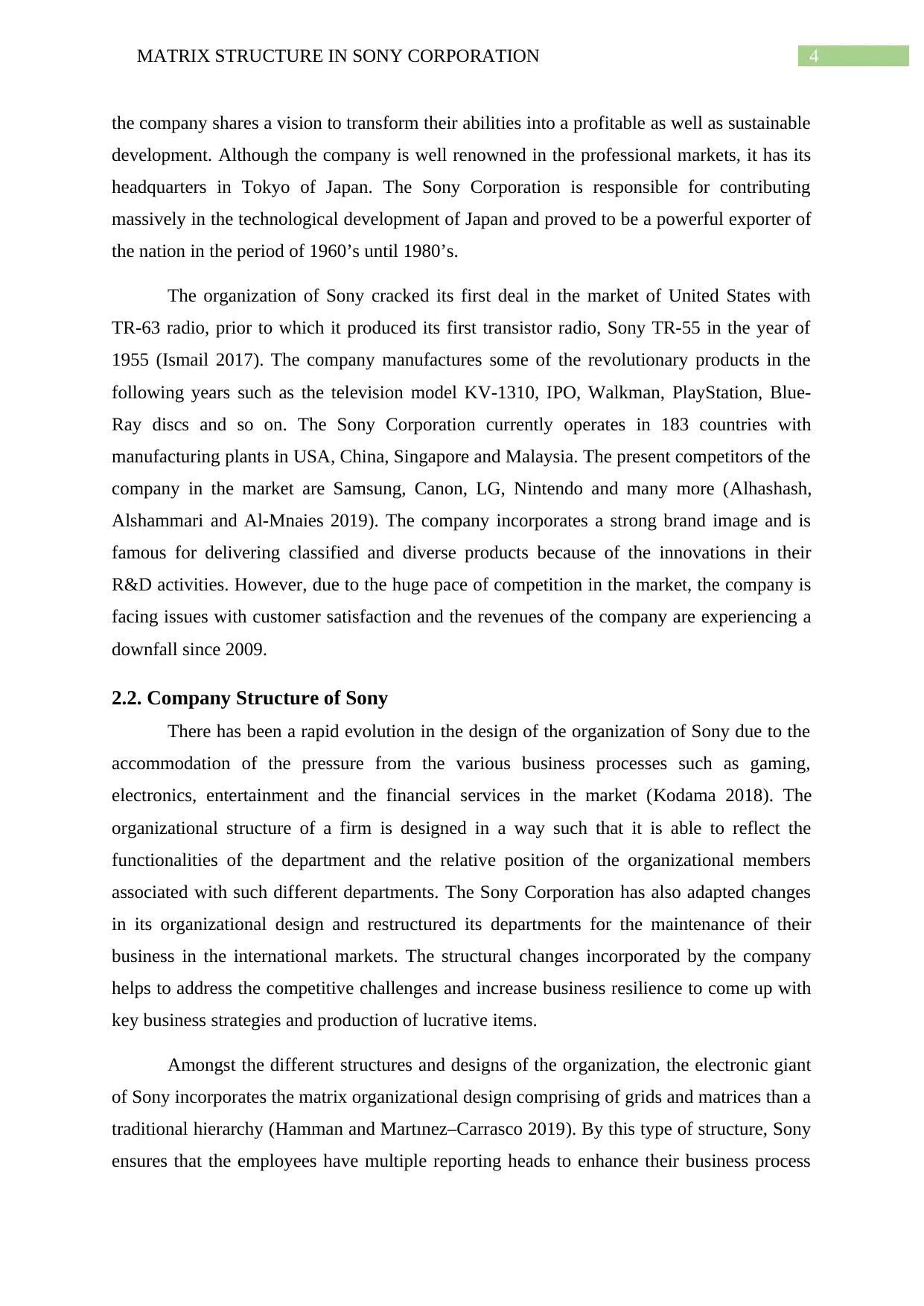
4MATRIX STRUCTURE IN SONY CORPORATION
the company shares a vision to transform their abilities into a profitable as well as sustainable
development. Although the company is well renowned in the professional markets, it has its
headquarters in Tokyo of Japan. The Sony Corporation is responsible for contributing
massively in the technological development of Japan and proved to be a powerful exporter of
the nation in the period of 1960’s until 1980’s.
The organization of Sony cracked its first deal in the market of United States with
TR-63 radio, prior to which it produced its first transistor radio, Sony TR-55 in the year of
1955 (Ismail 2017). The company manufactures some of the revolutionary products in the
following years such as the television model KV-1310, IPO, Walkman, PlayStation, Blue-
Ray discs and so on. The Sony Corporation currently operates in 183 countries with
manufacturing plants in USA, China, Singapore and Malaysia. The present competitors of the
company in the market are Samsung, Canon, LG, Nintendo and many more (Alhashash,
Alshammari and Al-Mnaies 2019). The company incorporates a strong brand image and is
famous for delivering classified and diverse products because of the innovations in their
R&D activities. However, due to the huge pace of competition in the market, the company is
facing issues with customer satisfaction and the revenues of the company are experiencing a
downfall since 2009.
2.2. Company Structure of Sony
There has been a rapid evolution in the design of the organization of Sony due to the
accommodation of the pressure from the various business processes such as gaming,
electronics, entertainment and the financial services in the market (Kodama 2018). The
organizational structure of a firm is designed in a way such that it is able to reflect the
functionalities of the department and the relative position of the organizational members
associated with such different departments. The Sony Corporation has also adapted changes
in its organizational design and restructured its departments for the maintenance of their
business in the international markets. The structural changes incorporated by the company
helps to address the competitive challenges and increase business resilience to come up with
key business strategies and production of lucrative items.
Amongst the different structures and designs of the organization, the electronic giant
of Sony incorporates the matrix organizational design comprising of grids and matrices than a
traditional hierarchy (Hamman and Martınez–Carrasco 2019). By this type of structure, Sony
ensures that the employees have multiple reporting heads to enhance their business process
the company shares a vision to transform their abilities into a profitable as well as sustainable
development. Although the company is well renowned in the professional markets, it has its
headquarters in Tokyo of Japan. The Sony Corporation is responsible for contributing
massively in the technological development of Japan and proved to be a powerful exporter of
the nation in the period of 1960’s until 1980’s.
The organization of Sony cracked its first deal in the market of United States with
TR-63 radio, prior to which it produced its first transistor radio, Sony TR-55 in the year of
1955 (Ismail 2017). The company manufactures some of the revolutionary products in the
following years such as the television model KV-1310, IPO, Walkman, PlayStation, Blue-
Ray discs and so on. The Sony Corporation currently operates in 183 countries with
manufacturing plants in USA, China, Singapore and Malaysia. The present competitors of the
company in the market are Samsung, Canon, LG, Nintendo and many more (Alhashash,
Alshammari and Al-Mnaies 2019). The company incorporates a strong brand image and is
famous for delivering classified and diverse products because of the innovations in their
R&D activities. However, due to the huge pace of competition in the market, the company is
facing issues with customer satisfaction and the revenues of the company are experiencing a
downfall since 2009.
2.2. Company Structure of Sony
There has been a rapid evolution in the design of the organization of Sony due to the
accommodation of the pressure from the various business processes such as gaming,
electronics, entertainment and the financial services in the market (Kodama 2018). The
organizational structure of a firm is designed in a way such that it is able to reflect the
functionalities of the department and the relative position of the organizational members
associated with such different departments. The Sony Corporation has also adapted changes
in its organizational design and restructured its departments for the maintenance of their
business in the international markets. The structural changes incorporated by the company
helps to address the competitive challenges and increase business resilience to come up with
key business strategies and production of lucrative items.
Amongst the different structures and designs of the organization, the electronic giant
of Sony incorporates the matrix organizational design comprising of grids and matrices than a
traditional hierarchy (Hamman and Martınez–Carrasco 2019). By this type of structure, Sony
ensures that the employees have multiple reporting heads to enhance their business process
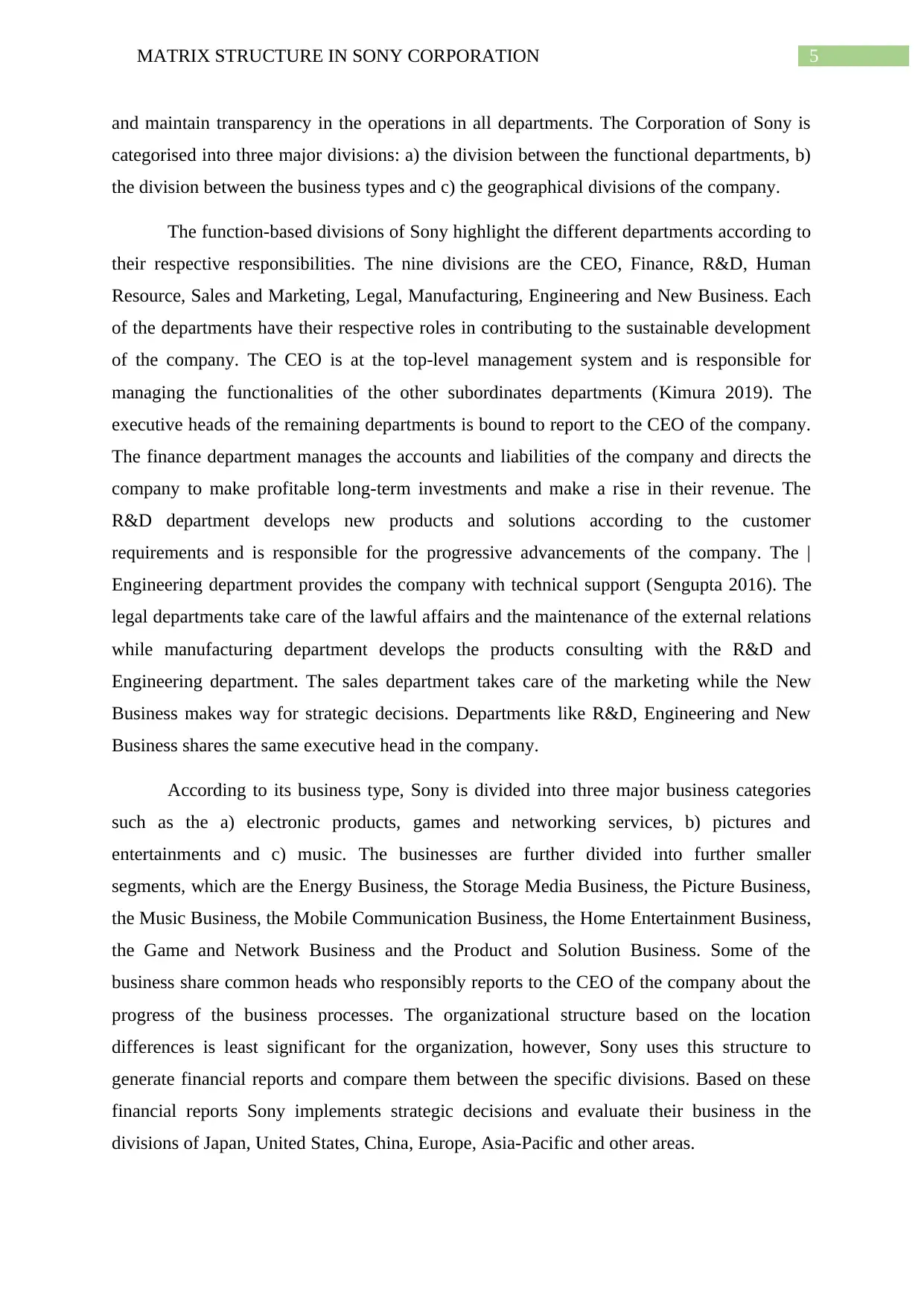
5MATRIX STRUCTURE IN SONY CORPORATION
and maintain transparency in the operations in all departments. The Corporation of Sony is
categorised into three major divisions: a) the division between the functional departments, b)
the division between the business types and c) the geographical divisions of the company.
The function-based divisions of Sony highlight the different departments according to
their respective responsibilities. The nine divisions are the CEO, Finance, R&D, Human
Resource, Sales and Marketing, Legal, Manufacturing, Engineering and New Business. Each
of the departments have their respective roles in contributing to the sustainable development
of the company. The CEO is at the top-level management system and is responsible for
managing the functionalities of the other subordinates departments (Kimura 2019). The
executive heads of the remaining departments is bound to report to the CEO of the company.
The finance department manages the accounts and liabilities of the company and directs the
company to make profitable long-term investments and make a rise in their revenue. The
R&D department develops new products and solutions according to the customer
requirements and is responsible for the progressive advancements of the company. The |
Engineering department provides the company with technical support (Sengupta 2016). The
legal departments take care of the lawful affairs and the maintenance of the external relations
while manufacturing department develops the products consulting with the R&D and
Engineering department. The sales department takes care of the marketing while the New
Business makes way for strategic decisions. Departments like R&D, Engineering and New
Business shares the same executive head in the company.
According to its business type, Sony is divided into three major business categories
such as the a) electronic products, games and networking services, b) pictures and
entertainments and c) music. The businesses are further divided into further smaller
segments, which are the Energy Business, the Storage Media Business, the Picture Business,
the Music Business, the Mobile Communication Business, the Home Entertainment Business,
the Game and Network Business and the Product and Solution Business. Some of the
business share common heads who responsibly reports to the CEO of the company about the
progress of the business processes. The organizational structure based on the location
differences is least significant for the organization, however, Sony uses this structure to
generate financial reports and compare them between the specific divisions. Based on these
financial reports Sony implements strategic decisions and evaluate their business in the
divisions of Japan, United States, China, Europe, Asia-Pacific and other areas.
and maintain transparency in the operations in all departments. The Corporation of Sony is
categorised into three major divisions: a) the division between the functional departments, b)
the division between the business types and c) the geographical divisions of the company.
The function-based divisions of Sony highlight the different departments according to
their respective responsibilities. The nine divisions are the CEO, Finance, R&D, Human
Resource, Sales and Marketing, Legal, Manufacturing, Engineering and New Business. Each
of the departments have their respective roles in contributing to the sustainable development
of the company. The CEO is at the top-level management system and is responsible for
managing the functionalities of the other subordinates departments (Kimura 2019). The
executive heads of the remaining departments is bound to report to the CEO of the company.
The finance department manages the accounts and liabilities of the company and directs the
company to make profitable long-term investments and make a rise in their revenue. The
R&D department develops new products and solutions according to the customer
requirements and is responsible for the progressive advancements of the company. The |
Engineering department provides the company with technical support (Sengupta 2016). The
legal departments take care of the lawful affairs and the maintenance of the external relations
while manufacturing department develops the products consulting with the R&D and
Engineering department. The sales department takes care of the marketing while the New
Business makes way for strategic decisions. Departments like R&D, Engineering and New
Business shares the same executive head in the company.
According to its business type, Sony is divided into three major business categories
such as the a) electronic products, games and networking services, b) pictures and
entertainments and c) music. The businesses are further divided into further smaller
segments, which are the Energy Business, the Storage Media Business, the Picture Business,
the Music Business, the Mobile Communication Business, the Home Entertainment Business,
the Game and Network Business and the Product and Solution Business. Some of the
business share common heads who responsibly reports to the CEO of the company about the
progress of the business processes. The organizational structure based on the location
differences is least significant for the organization, however, Sony uses this structure to
generate financial reports and compare them between the specific divisions. Based on these
financial reports Sony implements strategic decisions and evaluate their business in the
divisions of Japan, United States, China, Europe, Asia-Pacific and other areas.
⊘ This is a preview!⊘
Do you want full access?
Subscribe today to unlock all pages.

Trusted by 1+ million students worldwide
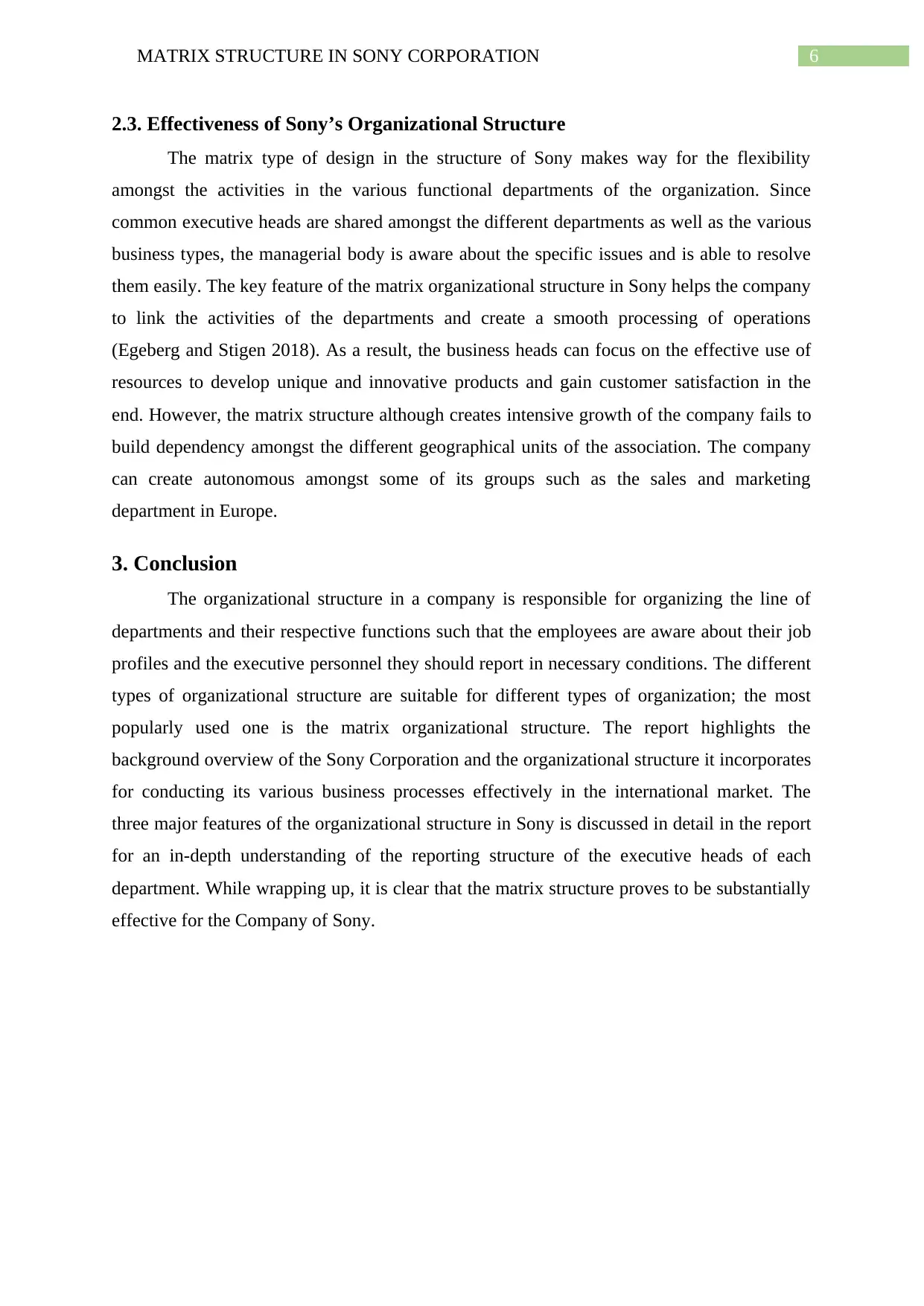
6MATRIX STRUCTURE IN SONY CORPORATION
2.3. Effectiveness of Sony’s Organizational Structure
The matrix type of design in the structure of Sony makes way for the flexibility
amongst the activities in the various functional departments of the organization. Since
common executive heads are shared amongst the different departments as well as the various
business types, the managerial body is aware about the specific issues and is able to resolve
them easily. The key feature of the matrix organizational structure in Sony helps the company
to link the activities of the departments and create a smooth processing of operations
(Egeberg and Stigen 2018). As a result, the business heads can focus on the effective use of
resources to develop unique and innovative products and gain customer satisfaction in the
end. However, the matrix structure although creates intensive growth of the company fails to
build dependency amongst the different geographical units of the association. The company
can create autonomous amongst some of its groups such as the sales and marketing
department in Europe.
3. Conclusion
The organizational structure in a company is responsible for organizing the line of
departments and their respective functions such that the employees are aware about their job
profiles and the executive personnel they should report in necessary conditions. The different
types of organizational structure are suitable for different types of organization; the most
popularly used one is the matrix organizational structure. The report highlights the
background overview of the Sony Corporation and the organizational structure it incorporates
for conducting its various business processes effectively in the international market. The
three major features of the organizational structure in Sony is discussed in detail in the report
for an in-depth understanding of the reporting structure of the executive heads of each
department. While wrapping up, it is clear that the matrix structure proves to be substantially
effective for the Company of Sony.
2.3. Effectiveness of Sony’s Organizational Structure
The matrix type of design in the structure of Sony makes way for the flexibility
amongst the activities in the various functional departments of the organization. Since
common executive heads are shared amongst the different departments as well as the various
business types, the managerial body is aware about the specific issues and is able to resolve
them easily. The key feature of the matrix organizational structure in Sony helps the company
to link the activities of the departments and create a smooth processing of operations
(Egeberg and Stigen 2018). As a result, the business heads can focus on the effective use of
resources to develop unique and innovative products and gain customer satisfaction in the
end. However, the matrix structure although creates intensive growth of the company fails to
build dependency amongst the different geographical units of the association. The company
can create autonomous amongst some of its groups such as the sales and marketing
department in Europe.
3. Conclusion
The organizational structure in a company is responsible for organizing the line of
departments and their respective functions such that the employees are aware about their job
profiles and the executive personnel they should report in necessary conditions. The different
types of organizational structure are suitable for different types of organization; the most
popularly used one is the matrix organizational structure. The report highlights the
background overview of the Sony Corporation and the organizational structure it incorporates
for conducting its various business processes effectively in the international market. The
three major features of the organizational structure in Sony is discussed in detail in the report
for an in-depth understanding of the reporting structure of the executive heads of each
department. While wrapping up, it is clear that the matrix structure proves to be substantially
effective for the Company of Sony.
Paraphrase This Document
Need a fresh take? Get an instant paraphrase of this document with our AI Paraphraser
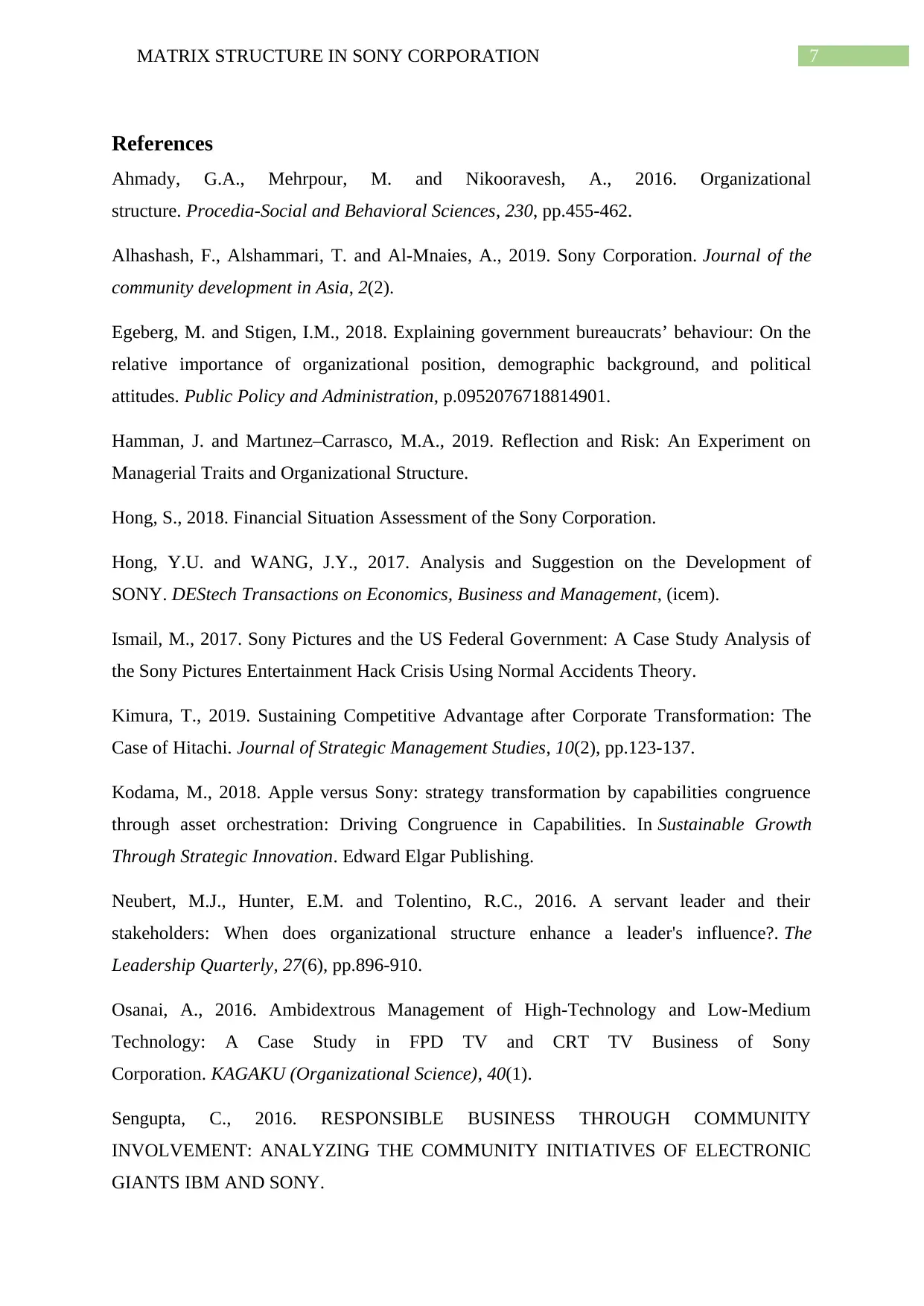
7MATRIX STRUCTURE IN SONY CORPORATION
References
Ahmady, G.A., Mehrpour, M. and Nikooravesh, A., 2016. Organizational
structure. Procedia-Social and Behavioral Sciences, 230, pp.455-462.
Alhashash, F., Alshammari, T. and Al-Mnaies, A., 2019. Sony Corporation. Journal of the
community development in Asia, 2(2).
Egeberg, M. and Stigen, I.M., 2018. Explaining government bureaucrats’ behaviour: On the
relative importance of organizational position, demographic background, and political
attitudes. Public Policy and Administration, p.0952076718814901.
Hamman, J. and Martınez–Carrasco, M.A., 2019. Reflection and Risk: An Experiment on
Managerial Traits and Organizational Structure.
Hong, S., 2018. Financial Situation Assessment of the Sony Corporation.
Hong, Y.U. and WANG, J.Y., 2017. Analysis and Suggestion on the Development of
SONY. DEStech Transactions on Economics, Business and Management, (icem).
Ismail, M., 2017. Sony Pictures and the US Federal Government: A Case Study Analysis of
the Sony Pictures Entertainment Hack Crisis Using Normal Accidents Theory.
Kimura, T., 2019. Sustaining Competitive Advantage after Corporate Transformation: The
Case of Hitachi. Journal of Strategic Management Studies, 10(2), pp.123-137.
Kodama, M., 2018. Apple versus Sony: strategy transformation by capabilities congruence
through asset orchestration: Driving Congruence in Capabilities. In Sustainable Growth
Through Strategic Innovation. Edward Elgar Publishing.
Neubert, M.J., Hunter, E.M. and Tolentino, R.C., 2016. A servant leader and their
stakeholders: When does organizational structure enhance a leader's influence?. The
Leadership Quarterly, 27(6), pp.896-910.
Osanai, A., 2016. Ambidextrous Management of High-Technology and Low-Medium
Technology: A Case Study in FPD TV and CRT TV Business of Sony
Corporation. KAGAKU (Organizational Science), 40(1).
Sengupta, C., 2016. RESPONSIBLE BUSINESS THROUGH COMMUNITY
INVOLVEMENT: ANALYZING THE COMMUNITY INITIATIVES OF ELECTRONIC
GIANTS IBM AND SONY.
References
Ahmady, G.A., Mehrpour, M. and Nikooravesh, A., 2016. Organizational
structure. Procedia-Social and Behavioral Sciences, 230, pp.455-462.
Alhashash, F., Alshammari, T. and Al-Mnaies, A., 2019. Sony Corporation. Journal of the
community development in Asia, 2(2).
Egeberg, M. and Stigen, I.M., 2018. Explaining government bureaucrats’ behaviour: On the
relative importance of organizational position, demographic background, and political
attitudes. Public Policy and Administration, p.0952076718814901.
Hamman, J. and Martınez–Carrasco, M.A., 2019. Reflection and Risk: An Experiment on
Managerial Traits and Organizational Structure.
Hong, S., 2018. Financial Situation Assessment of the Sony Corporation.
Hong, Y.U. and WANG, J.Y., 2017. Analysis and Suggestion on the Development of
SONY. DEStech Transactions on Economics, Business and Management, (icem).
Ismail, M., 2017. Sony Pictures and the US Federal Government: A Case Study Analysis of
the Sony Pictures Entertainment Hack Crisis Using Normal Accidents Theory.
Kimura, T., 2019. Sustaining Competitive Advantage after Corporate Transformation: The
Case of Hitachi. Journal of Strategic Management Studies, 10(2), pp.123-137.
Kodama, M., 2018. Apple versus Sony: strategy transformation by capabilities congruence
through asset orchestration: Driving Congruence in Capabilities. In Sustainable Growth
Through Strategic Innovation. Edward Elgar Publishing.
Neubert, M.J., Hunter, E.M. and Tolentino, R.C., 2016. A servant leader and their
stakeholders: When does organizational structure enhance a leader's influence?. The
Leadership Quarterly, 27(6), pp.896-910.
Osanai, A., 2016. Ambidextrous Management of High-Technology and Low-Medium
Technology: A Case Study in FPD TV and CRT TV Business of Sony
Corporation. KAGAKU (Organizational Science), 40(1).
Sengupta, C., 2016. RESPONSIBLE BUSINESS THROUGH COMMUNITY
INVOLVEMENT: ANALYZING THE COMMUNITY INITIATIVES OF ELECTRONIC
GIANTS IBM AND SONY.
1 out of 8
Related Documents
Your All-in-One AI-Powered Toolkit for Academic Success.
+13062052269
info@desklib.com
Available 24*7 on WhatsApp / Email
![[object Object]](/_next/static/media/star-bottom.7253800d.svg)
Unlock your academic potential
Copyright © 2020–2025 A2Z Services. All Rights Reserved. Developed and managed by ZUCOL.





